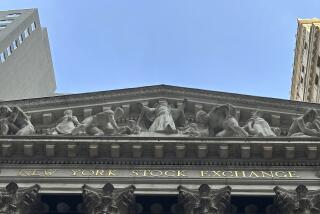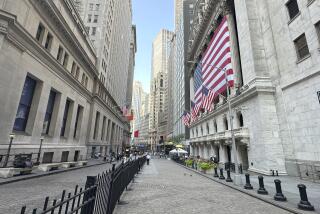Cosmic Events Haven’t Shaken Wall Street--Yet
Wall Street survived the Great Solar Eclipse of 1991 on Thursday. And you can thank your lucky stars, because normally the stock market isn’t so fortunate.
New York-based astrologer and market forecaster Arch Crawford, whose Crawford Perspectives newsletter has built up quite a following charting stock prices with planetary comings and goings, says an eclipse usually produces “a big down day” in the market.
On Thursday, the Dow Jones industrial average managed to rise 14.98 points to 2,959.75. But Crawford notes that the market overall suffered through a “very, very choppy day.” And when the moon’s eclipse of the sun reached its greatest point of coverage in New York at 3:07 p.m. EDT, the Dow quickly slumped about 20 points from its peak, Crawford notes.
The unbelievers may put Crawford’s expertise in the same class as palm reading, channeling and Shirley MacLaine, but he points to the moon’s effect on the tides as an example of cosmic forces at work on Earth.
Depending on their juxtaposition in the heavens, Crawford says, “The planets act as a force on the magnetosphere of the sun and can touch off sunspots. That causes magnetic storms on Earth, which have a tendency to make people feel nervous.” Ergo , trouble for stocks.
That’s the physiological explanation. Beyond that, he admits, there is simply “classical astrology,” by which he and others show that certain planetary formations have historically meant either good or bad karma for financial markets. Don’t kill the messenger just for reading the charts, he says. Things happen, “but why they should, I don’t know.”
Anyway, back to the eclipse: Given that Wall Street overcame the darkness of the day, isn’t that bullish for stocks? Maybe short term, Crawford says. But he sees a 600- to 1,000-point plunge in the Dow later this summer because too many other negative cosmic events are, er, on the horizon:
* Saturn is contracting.
* On Tuesday, Jupiter squares Pluto.
* Around Aug. 30, you get a T-squared in the heliocentric sky, with Mercury, Mars and Uranus forming a T pattern that is inherently negative.
So for stocks, at least, the ruling constellation for a while looks like Ursa Major--the bear.
More to Read
Sign up for Essential California
The most important California stories and recommendations in your inbox every morning.
You may occasionally receive promotional content from the Los Angeles Times.










